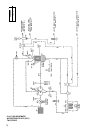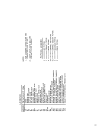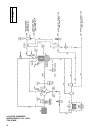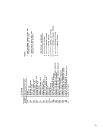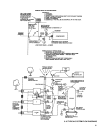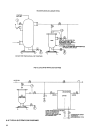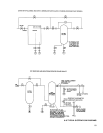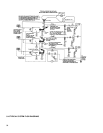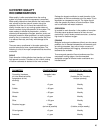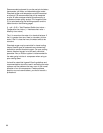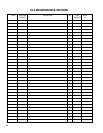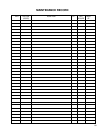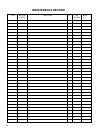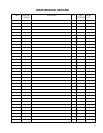
85
9.0 WATER QUALITY
RECOMMENDATIONS
Water quality is often overlooked when the cooling
system of a water cooled air compressor is examined.
Water quality determines how effective the heat transfer
rate, as well as the flow rate will remain during the
operation life of the unit. It should be noted that the
quality of water used in any cooling system does not
remain constant during the operation of the system. The
water makeup is affected by evaporation, corrosion,
chemical and temperature changes, aeration, scale, and
biological formations. Most problems in a cooling system
show up first in a reduction in the heat transfer rate, then
in a reduced flow rate, and finally with damage to the
system.
There are many constituents in the water system that
must be balanced to have a good stable system.The
following is a list of the major components that should be
monitored:
SCALE
Scale formation inhibits effective heat transfer, yet it does
help prevent corrosion. Therefore, a thin uniform coating
of calcium carbonate is desired on the inner surfaces.
Perhaps the largest contributor to scale formation is the
precipitation of calcium carbonate out of the water. This is
dependent on temperature and pH. The higher the pH
value the greater the chance of scale formation. Scale
can be controlled with water treatment.
CORROSION
In contrast to scale formation is the problem of corrosion.
Chlorides cause problems because of their size and
conductivity. Low pH levels promote corrosion, as well as
high levels of dissolved oxygen.
FOULING
Biological and organic substances (slime) can also cause
problems, but in elevated temperature environments such
as cooling processes, they are not major concerns. If
they create problems with clogging, commercial shock
treatments are available.
To ensure good operation life and performance of the
compressor cooling system, the recommended
acceptable ranges for different water constituents are
included below:
PARAMETER
Corrosivity (hardness,
pH, total dissolved solids,
temperature at inlet,
alkalinity)
Iron
Sulfate
Chloride
Nitrate
Silica
Dissolved oxygen
Oil and grease
Ammonia
CONCENTRATION
Langelier Index
0 to 1
< 2 ppm
< 50 ppm
< 50 ppm
< 2 ppm
< 100 ppm
0 ppm
(as low as possible)
< 5 ppm
< 1 ppm
FREQUENCY OF ANALYSIS
Monthly
(if stable for 3 to 4 months,
analyze quarterly)
Monthly
Monthly
Monthly
Monthly
Monthly
Daily
(if stable, analyze weekly)
Monthly
Monthly



